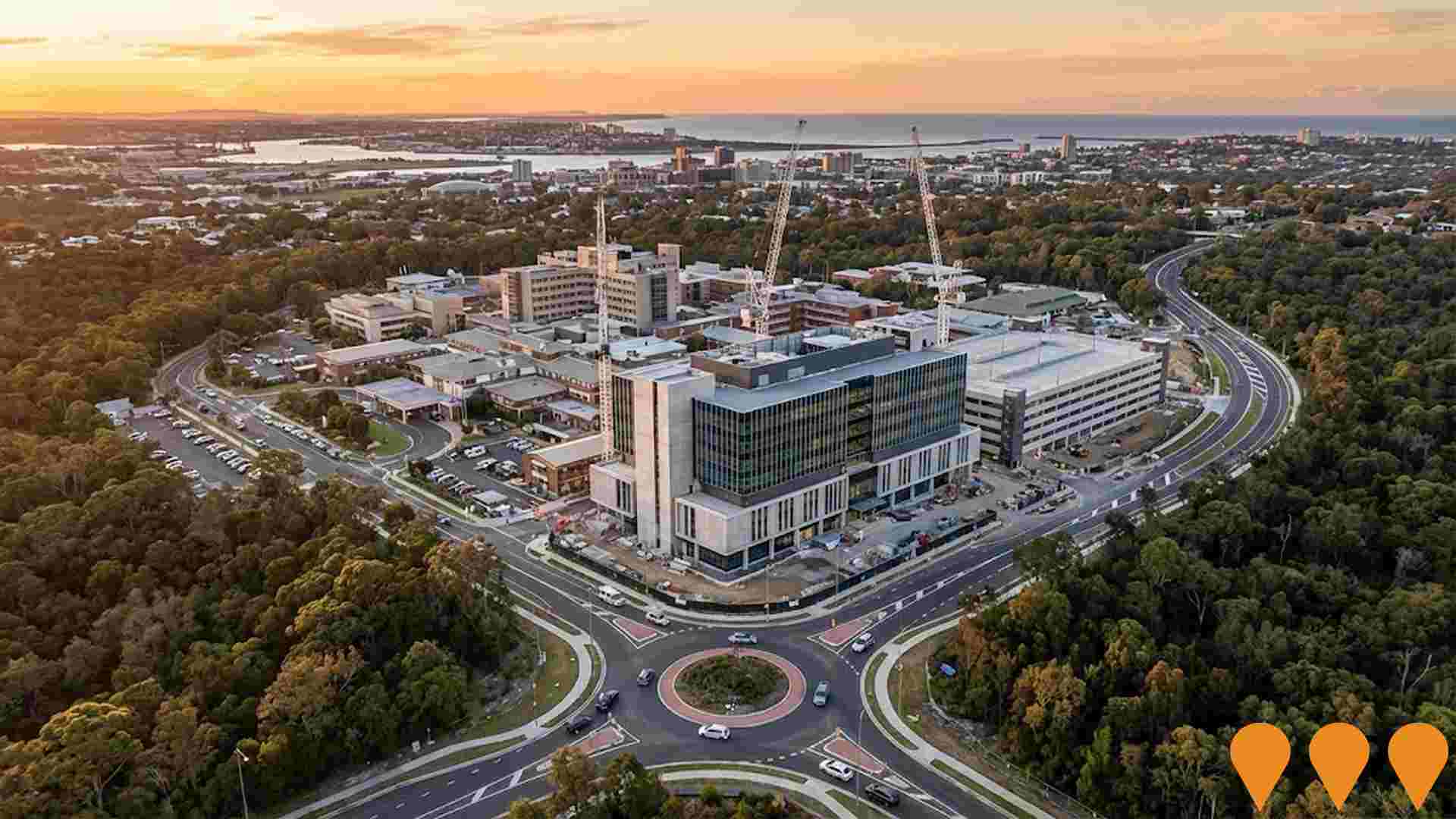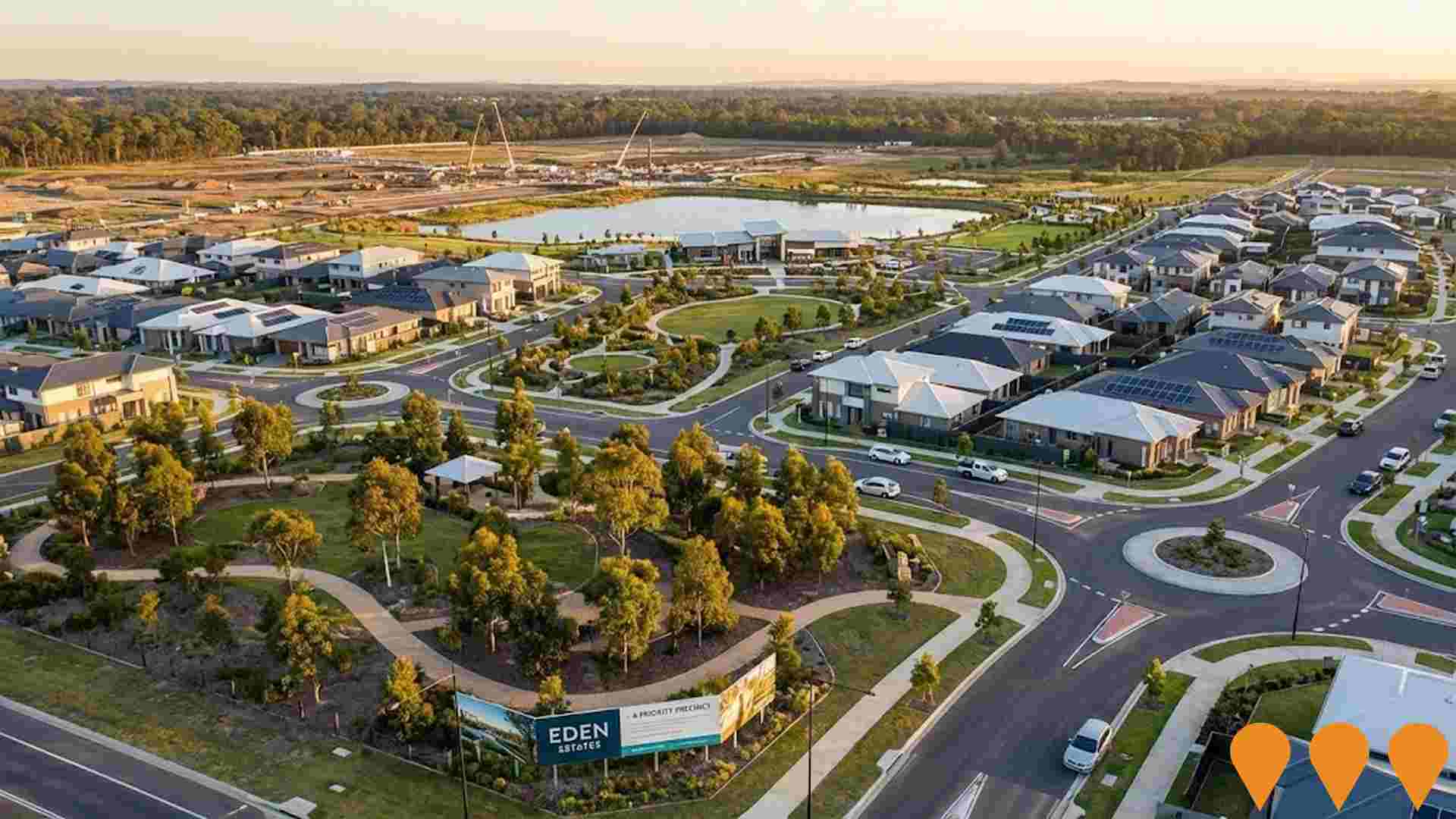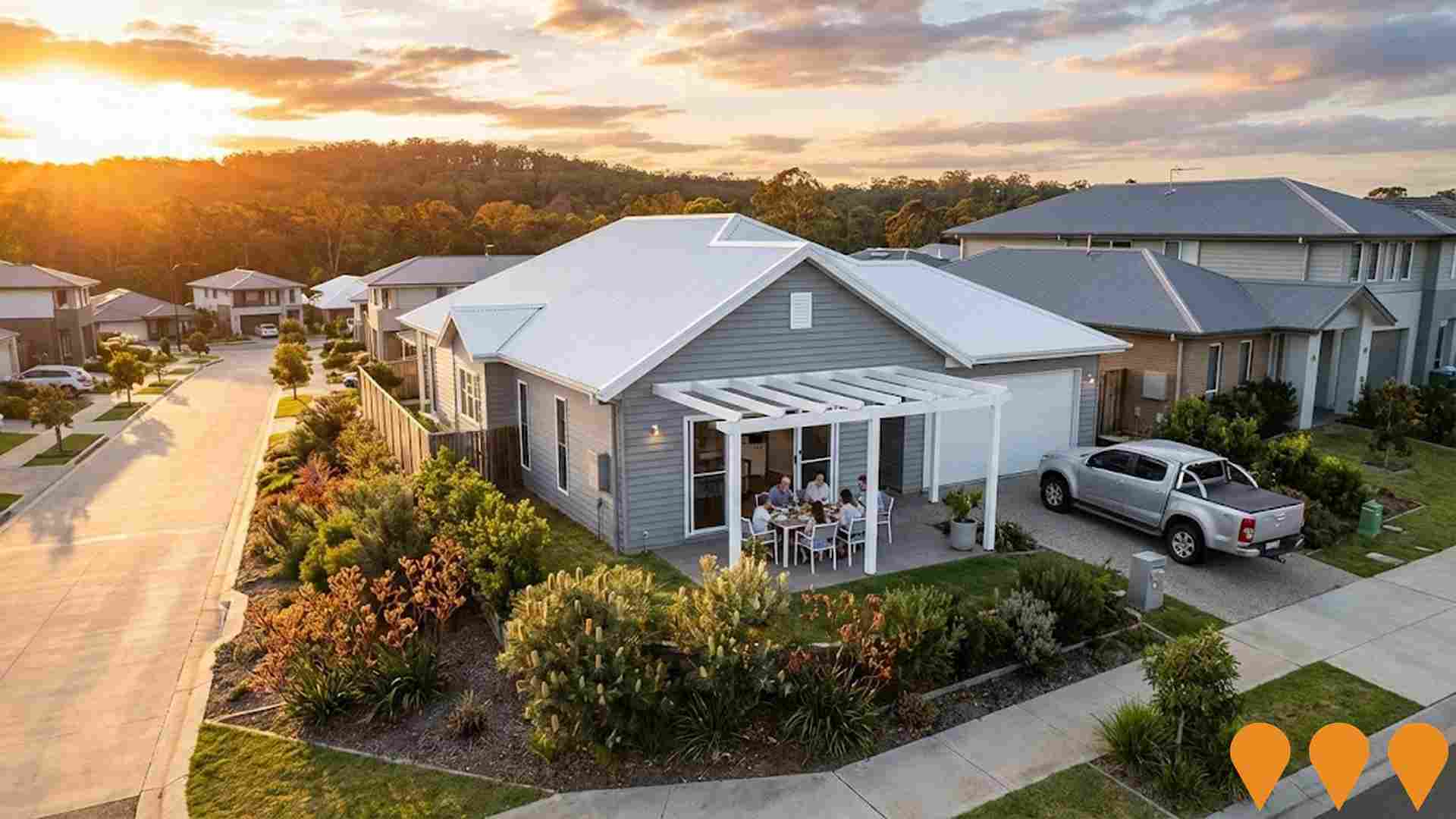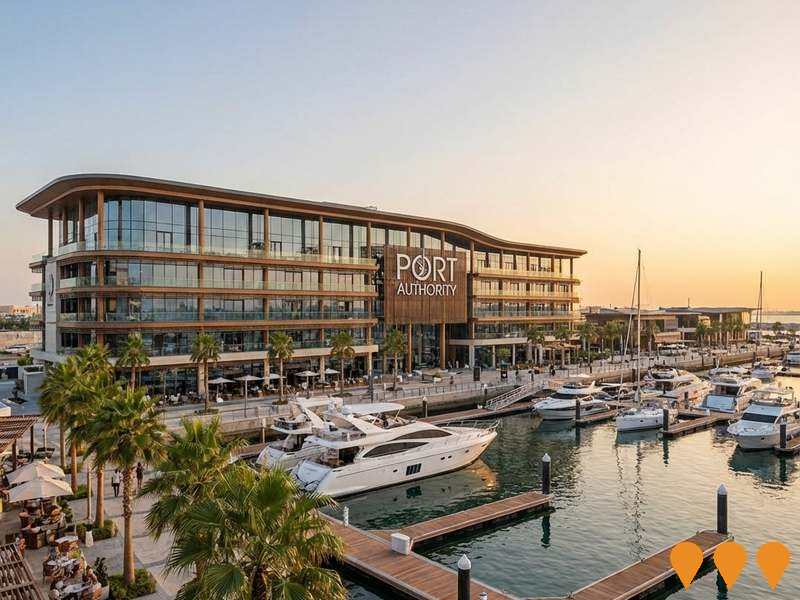Chart Color Schemes
est. as @ -- *
ABS ERP | -- people | --
2021 Census | -- people
Sales Activity
Curious about local property values? Filter the chart to assess the volume and appreciation (including resales) trends and regional comparisons, or scroll to the map below view this information at an individual property level.
Find a Recent Sale
Sales Detail
Population
Population growth drivers in Wallsend - Elermore Vale are strong compared to national averages based on AreaSearch's ranking of recent, and medium to long-term trends
Wallsend - Elermore Vale's population is around 21,801 as of August 2025. This reflects an increase of 4.0% since the 2021 Census, which reported a population of 20,958 people. The change was inferred from the estimated resident population of 21,691 in June 2024 and an additional 242 validated new addresses since the Census date. This level of population equates to a density ratio of 1,013 persons per square kilometer. Wallsend - Elermore Vale's growth rate positions it within 0.8 percentage points of the non-metro area (4.8%), demonstrating competitive growth fundamentals. Population growth was primarily driven by overseas migration contributing approximately 62.0% of overall population gains during recent periods.
AreaSearch is adopting ABS/Geoscience Australia projections for each SA2 area, released in 2024 with a base year of 2022. For areas not covered, AreaSearch utilises NSW State Government's SA2 level projections, released in 2022 with a base year of 2021. Growth rates by age group are applied to all areas for years 2032 to 2041. Based on demographic trends and latest population numbers, the area is projected to expand by 3,041 persons to 2041, reflecting an increase of 13.4% over the 17-year period.
Frequently Asked Questions - Population
Development
AreaSearch assessment of residential approval activity sees Wallsend - Elermore Vale among the top 30% of areas assessed nationwide
Between fiscal years 2021 and 2025, Wallsend - Elermore Vale approved approximately 456 new homes. In the current fiscal year 2026, around 20 homes have been approved so far. On average, each dwelling built over these five financial years attracted about 2.2 new residents annually.
The average construction cost of new homes is $410,000, consistent with regional trends. This year has seen commercial approvals totaling $10.4 million, indicating moderate commercial development activity. Compared to the rest of NSW, Wallsend - Elermore Vale has around three-quarters the rate of new dwelling approvals per person and ranks in the 56th percentile nationally when measured against other areas assessed. The current housing mix consists of approximately 30% detached dwellings and 70% attached dwellings, a shift from the previous composition of 80% houses. This change reflects reduced availability of development sites and evolving lifestyle demands and affordability requirements.
With around 337 people per dwelling approval, Wallsend - Elermore Vale exhibits characteristics of a low-density area. By 2041, the population is projected to grow by approximately 2,931 residents. Development activity is keeping pace with this projected growth, though increasing competition among buyers can be expected as the population expands.
Frequently Asked Questions - Development
Infrastructure
Wallsend - Elermore Vale has strong levels of nearby infrastructure activity, ranking in the top 30% nationally
Changes to local infrastructure significantly impact an area's performance. AreaSearch has identified 38 projects likely affecting the region. Notable initiatives include Western Corridor Road Upgrades along Longworth Avenue and Minmi Road, Infinite Early Learning Elermore Vale, 6-10 Council Street Apartments, and West Wallsend Learn-to-Swim Pool. The following list details projects most relevant to the area.
Professional plan users can use the search below to filter and access additional projects.
INFRASTRUCTURE SEARCH
 Denotes AI-based impression for illustrative purposes only, not to be taken as definitive under any circumstances. Please follow links and conduct other investigations from the project's source for actual imagery. Developers and project owners wishing us to use original imagery please Contact Us and we will do so.
Denotes AI-based impression for illustrative purposes only, not to be taken as definitive under any circumstances. Please follow links and conduct other investigations from the project's source for actual imagery. Developers and project owners wishing us to use original imagery please Contact Us and we will do so.
Frequently Asked Questions - Infrastructure
John Hunter Health and Innovation Precinct
The John Hunter Health and Innovation Precinct is the redevelopment and expansion of John Hunter Hospital in New Lambton Heights, Newcastle. The project centres on a new seven-storey Acute Services Building delivering an expanded Emergency Department, 60% more ICU capacity, 50% additional operating theatres, new maternity and birthing suites, neonatal intensive care, paediatric services, research and innovation spaces, public realm improvements and a multi-storey car park. The $835 million project is being delivered by Health Infrastructure NSW in partnership with Hunter New England Local Health District, with Multiplex as the managing contractor and BVN as lead architect. Practical completion is anticipated in 2026.

Western Corridor Road Upgrades - Longworth Avenue and Minmi Road
Major dual-lane road upgrades along Longworth Avenue (Newcastle Road to Cameron Street) and Minmi Road (Maryland Drive to Summerhill Road roundabout) in Wallsend. The project includes widening roads to four lanes (two lanes each direction), removing difficult right turns, adding dedicated turning lanes, improved cycling and pedestrian connections, upgraded stormwater infrastructure, and intersection improvements. Daracon is the principal contractor, with construction commenced March 2025 and completion expected mid-2026. Funded by City of Newcastle with $7.61 million contribution from NSW Government's Accelerated Infrastructure Fund.

Lambton Park Master Plan
A comprehensive master plan approved by Newcastle Council in May 2025 to guide the future development of Lambton Park. The plan focuses on enhancing facilities, community engagement, heritage preservation, and recreational opportunities while maintaining the park as an open green space. Key developments include Lambton Pool upgrades, heritage rotunda preservation, improved accessibility, tennis courts, bowling club facilities, children's playgrounds, walking tracks, and the transformation of the former Baby Health Centre into a modern cafe.

Infinite Early Learning Elermore Vale
A 141-place state-of-the-art childcare centre with six indoor play areas, originally planned as a medical and childcare facility including pharmacy, cafe, and pathology services, now changed to childcare only and under construction, set to open in Q3 2025.

Eden Estates
State-significant masterplanned residential precinct spanning approximately 574 hectares across Newcastle and Lake Macquarie LGAs. The rezoning proposal seeks to deliver up to 4,200 new dwellings, employment lands, community facilities, open space and conservation areas. Declared a Priority Precinct by the NSW Government in 2024 with public exhibition of the draft planning package occurring November-December 2024.

Duncan Close Residential Development
Staged development of 49 multi-dwelling homes on a vacant lot, including shared outdoor space and associated site works.

Elermore Fields Estate
A 4.20 hectare residential estate in Elermore Vale, offering 42 lots for house and land packages. Nestled in a family-friendly suburb with access to public transport, shopping centres, quality schools, parks, and close to Newcastle CBD.

Elermore Ridge
A residential community featuring 106 homes over six stages, including two and three bedroom designs in single-level, split-level, and townhouse formats with contemporary finishes, gourmet kitchens with stone benchtops and stainless steel appliances, spacious open-plan living areas, and private terraces with gas outlets for outdoor entertaining. The community offers wide streets, tree-shaded parkland areas, and easy access to major amenities.

Employment
Wallsend - Elermore Vale shows employment indicators that trail behind approximately 70% of regions assessed across Australia
Wallsend-Elermore Vale has a skilled workforce with prominent representation in essential services sectors. The unemployment rate was 4.6% as of June 2021, with an estimated employment growth of 1.9% over the past year.
As of June 2025, 11,028 residents are employed, while the unemployment rate is 4.6%, 0.9% higher than Rest of NSW's rate of 3.7%. Workforce participation is similar to Rest of NSW at 56.4%. Dominant employment sectors include health care & social assistance, retail trade, and education & training, with healthcare notably concentrated at 1.3 times the regional average. Agriculture, forestry & fishing has limited presence at 0.5% compared to 5.3% regionally.
Employment opportunities locally appear limited based on Census working population vs resident population comparison. Between June 2024 and June 2025, employment levels increased by 1.9%, labour force by 2.5%, causing unemployment rate to rise by 0.6 percentage points. In contrast, Rest of NSW saw employment fall by 0.1%, labour force expand by 0.3%, and unemployment rise by 0.4 percentage points. Jobs and Skills Australia's national employment forecasts from May 2025 project overall growth of 6.6% over five years and 13.7% over ten years, but growth rates vary significantly between sectors. Applying these projections to Wallsend-Elermore Vale's employment mix suggests local growth of approximately 6.9% over five years and 14.5% over ten years.
Frequently Asked Questions - Employment
Income
The area's income profile falls below national averages based on AreaSearch analysis
Wallsend - Elermore Vale had a median taxpayer income of $53,183 and an average income of $62,737 in the financial year 2022. This was slightly lower than the national average, with Rest of NSW having a median income of $49,459 and an average income of $62,998. By September 2025, estimated incomes would be approximately $59,889 (median) and $70,648 (average), based on Wage Price Index growth of 12.61% since financial year 2022. According to the 2021 Census, household, family, and personal incomes in Wallsend - Elermore Vale ranked modestly, between the 31st and 34th percentiles. Income distribution data showed that 31.5% of locals (6,867 people) fell into the $1,500 - 2,999 category, similar to the surrounding region where 29.9% occupied this bracket. Housing affordability pressures were severe, with only 82.0% of income remaining after housing costs, ranking at the 32nd percentile. The area's SEIFA income ranking placed it in the 4th decile.
Frequently Asked Questions - Income
Housing
Wallsend - Elermore Vale is characterized by a predominantly suburban housing profile, with above-average rates of outright home ownership
The dwelling structure in Wallsend - Elermore Vale, as per the latest Census, consisted of 79.6% houses and 20.4% other dwellings (semi-detached, apartments, 'other' dwellings). In contrast, Non-Metro NSW had 70.5% houses and 29.5% other dwellings. Home ownership in Wallsend - Elermore Vale was at 33.1%, with the remaining dwellings being mortgaged (33.8%) or rented (33.1%). The median monthly mortgage repayment in the area was $1,777, lower than Non-Metro NSW's average of $1,962. The median weekly rent figure was recorded at $380, compared to Non-Metro NSW's $400. Nationally, Wallsend - Elermore Vale's mortgage repayments were lower than the Australian average of $1,863, while rents exceeded the national figure of $375.
Frequently Asked Questions - Housing
Household Composition
Wallsend - Elermore Vale features high concentrations of group households, with a fairly typical median household size
Family households constitute 66.3% of all households, including 26.5% couples with children, 25.7% couples without children, and 12.8% single parent families. Non-family households comprise the remaining 33.7%, with lone person households at 28.9% and group households making up 4.8%. The median household size is 2.4 people, which aligns with the average for the Rest of NSW.
Frequently Asked Questions - Households
Local Schools & Education
Educational outcomes in Wallsend - Elermore Vale fall within the lower quartile nationally, indicating opportunities for improvement in qualification attainment
Wallsend-Elermore Vale's residents aged 15+ have a university degree rate of 23.8%, compared to NSW's 32.2%. Bachelor degrees are the most common at 16.6%, followed by postgraduate qualifications (5.3%) and graduate diplomas (1.9%). Vocational credentials are held by 36.2% of residents, with advanced diplomas at 9.6% and certificates at 26.6%. Current educational participation is high at 27.5%, including 8.3% in primary, 6.6% in secondary, and 6.2% in tertiary education.
There are six schools in the area educating approximately 2,566 students, with typical Australian school conditions (ICSEA: 998). Five primary and one secondary school serve distinct age groups. School places per 100 residents (11.8) fall below the regional average (15.6), suggesting some students attend schools in adjacent areas.
Frequently Asked Questions - Education
Schools Detail
Nearby Services & Amenities
Transport
Transport servicing is good compared to other areas nationally based on assessment of service frequency, route connectivity and accessibility
The analysis shows that Wallsend - Elermore Vale has 203 active public transport stops, all of which are bus stops. These stops are served by 105 different routes, offering a total of 2,570 weekly passenger trips combined. The accessibility to these transport services is rated as excellent, with residents generally located just 136 meters away from the nearest stop.
On average, there are 367 trips per day across all routes, which translates to about 12 weekly trips per individual stop.
Frequently Asked Questions - Transport
Transport Stops Detail
Health
Health performance in Wallsend - Elermore Vale is well below average with a range of health conditions having marked impacts on both younger and older age cohorts
Wallsend - Elermore Vale faces significant health challenges, with various conditions affecting both younger and older residents. The area has approximately 51% private health cover, slightly lower than the average SA2 area and Rest of NSW at 55.6%.
Mental health issues and arthritis are the most common conditions, impacting 11.5% and 10.1% of residents respectively. About 59.9% of residents report no medical ailments, compared to 64.9% in Rest of NSW. The area has a higher proportion of seniors aged 65 and over at 20.0%, or 4,358 people, compared to 16.7% in Rest of NSW. Senior health outcomes present challenges broadly similar to the general population's health profile.
Frequently Asked Questions - Health
Cultural Diversity
Wallsend - Elermore Vale ranks below the Australian average when compared to other local markets across a number of language and cultural background related metrics
Wallsend-Elermore Vale had below average cultural diversity, with 84.6% of its population born in Australia, 89.6% being citizens, and 87.8% speaking English only at home. Christianity was the predominant religion, comprising 51.8%. Islam's representation stood out at 2.5%, higher than the Rest of NSW's 1.7%.
The top three ancestry groups were English (29.0%), Australian (28.4%), and Scottish (8.3%). Notably, Macedonian (1.2%) was overrepresented compared to regional figures (0.8%), as were Polish (1.1% vs 0.8%) and Welsh (0.8% vs 0.8%).
Frequently Asked Questions - Diversity
Age
Wallsend - Elermore Vale's population is slightly older than the national pattern
The median age in Wallsend - Elermore Vale is 39 years, which is significantly lower than Rest of NSW's average of 43 but essentially aligned with Australia's median age of 38 years. Compared to Rest of NSW, Wallsend - Elermore Vale has a higher proportion of residents aged 25-34 (17.3%) but fewer residents aged 65-74 (9.4%). According to the 2021 Census, the age group of 25 to 34 years grew from 14.7% to 17.3% of the population. Conversely, the age groups of 55 to 64 years and 65 to 74 years declined from 11.2% to 9.9% and 10.7% to 9.4%, respectively. By 2041, demographic projections indicate significant shifts in Wallsend - Elermore Vale's age structure. Notably, the 25 to 34 age group is expected to grow by 30%, reaching a population of 4,899 from 3,769 currently. Conversely, the age groups of 65 to 74 and 55 to 64 are projected to experience population declines.


